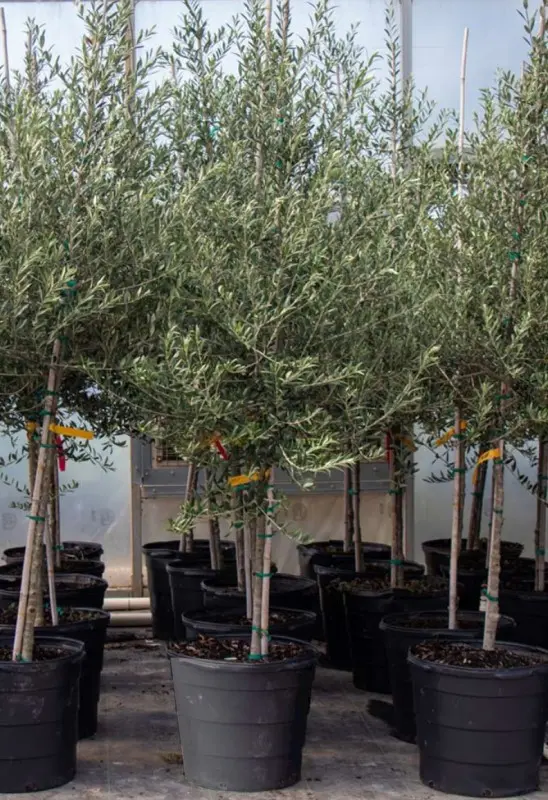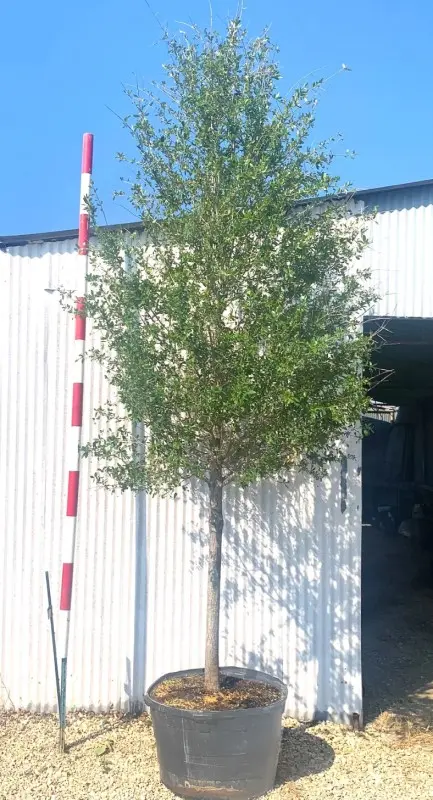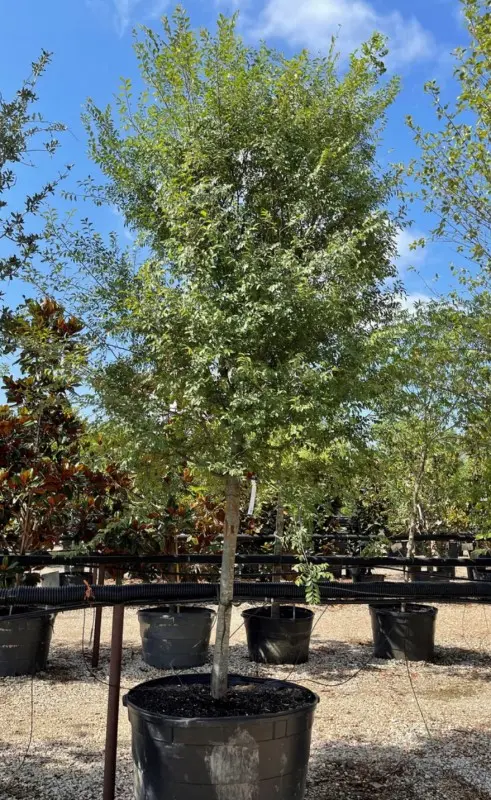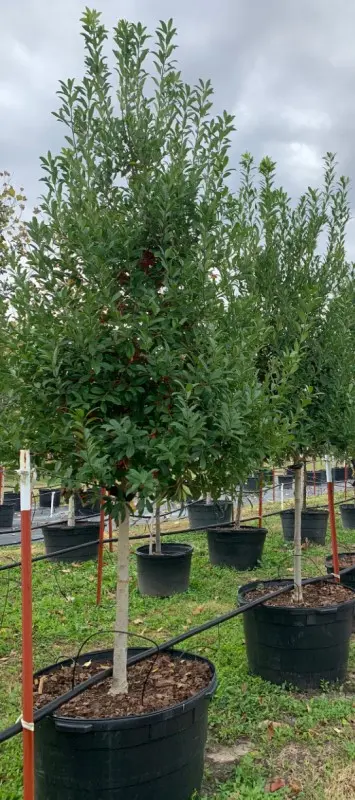-

Paulo Verde Tree
$0.00
Deciduous (loose leaves in winter)
Up to 25'
Grown up to 12" per year
-
Palo Verde (Parkinsonia spp.), often called the "green stick" tree, is a unique, deciduous tree native to the southwestern United States and northern Mexico, admired for its vibrant green bark and ability to thrive in arid desert environments. Its green bark is an adaptation that allows the tree to perform photosynthesis even when its small, delicate leaves are shed during dry periods, helping it conserve water and sustain itself in extreme climates. In spring, Palo Verde produces abundant clusters of bright yellow flowers that attract pollinators, creating a vivid seasonal display.
Several common varieties of Palo Verde are known for their distinct characteristics and adaptability. The Blue Palo Verde (Parkinsonia florida) features bluish-green bark, larger leaves, and grows up to 30 feet tall and wide. The Foothill Palo Verde (Parkinsonia microphylla) has smaller leaves, a more compact form, and reaches about 20 feet in height and width. The popular hybrid ‘Desert Museum’ Palo Verde (Parkinsonia x 'Desert Museum') combines the best traits of its parent species, growing rapidly to about 30 feet tall and 40 feet wide, producing larger flowers and featuring a thornless structure.
Palo Verde trees thrive in full sun, requiring at least six hours of direct sunlight daily and performing best in well-draining soils, including sandy and rocky types. While they are highly drought-tolerant once established, young trees benefit from regular watering to develop strong root systems. Palo Verde requires minimal maintenance, with pruning mainly done to remove dead or crossing branches. Ecologically, these trees support desert ecosystems by providing food and habitat for wildlife and serving as nurse plants for young cacti. Recognized as the state tree of Arizona, the Palo Verde adds beauty and resilience to desert landscapes with its striking green bark, seasonal yellow blooms, and essential role in supporting desert life.
-

Olive Tree
$0.00
Evergreen
Slow growth rate
Up to 25'
-
Olive Tree (Olea europaea) is an evergreen tree native to the Mediterranean region, renowned for its silvery-green foliage, gnarled trunk, and edible fruit. Cultivated for thousands of years, Olive trees are highly valued for their olives and olive oil, as well as their ornamental beauty in landscapes. The tree’s narrow, elongated leaves are dark green on top and silvery-gray underneath, creating a distinctive, shimmering appearance. Olive trees bloom in late spring, producing small, fragrant, creamy-white flowers that give way to green fruits, which ripen to a purplish-black or dark green in late summer or early fall.
Typically growing 20 to 30 feet tall and wide, Olive trees have a slow to moderate growth rate and can live for centuries, with many specimens displaying their signature twisting, gnarled trunks as they age. They thrive in USDA zones 8-11, preferring full sun and well-draining soil with a slightly alkaline pH. Olive trees are drought-tolerant once established and can withstand hot, dry climates as well as coastal conditions, making them ideal for Mediterranean and arid landscapes. While they are frost-sensitive, certain cold-hardy varieties can withstand brief dips in temperature, allowing them to grow in slightly cooler regions.
Low-maintenance and relatively pest-resistant, Olive trees require minimal pruning, typically in late winter to early spring, to shape or control size. They are often used as specimen trees, in groves, or in pots, bringing a classic, Mediterranean aesthetic to gardens, courtyards, and patios. With their elegant foliage, historical significance, and adaptability, Olive trees add both functional and ornamental value, creating a timeless look in landscapes that recalls the warmth and heritage of the Mediterranean.
-

Live Oak
$0.00
Evergreen
Grow up to 24" per year
Up to 70'
-
Live Oak (Quercus virginiana), also known as Southern Live Oak, is an iconic, evergreen oak tree admired for its sprawling, majestic form and resilience in a variety of landscapes. Native to the southeastern United States, this tree features dark, glossy green leaves that are oblong and leathery, remaining on the tree year-round. Its branches spread wide and low, often creating a canopy much wider than the tree’s height, which can reach 40 to 80 feet tall and spread up to 100 feet or more. The gnarled, sprawling limbs of the Live Oak make it especially striking, creating a dramatic, ancient appearance in mature trees.
Thriving in USDA zones 7-10, Live Oak prefers full sun and can adapt to various well-draining soil types, including sandy, clay, and loamy soils. Known for its durability, this tree is highly tolerant of drought, salt, and even occasional flooding, making it suitable for both coastal and inland landscapes. Once established, Live Oak requires minimal watering, making it an excellent choice for low-maintenance or xeriscape gardens in warmer climates.
Low-maintenance and long-lived, Live Oaks require little pruning except to remove dead or crossing branches. Their dense, spreading canopy makes them popular shade trees in parks, large residential landscapes, and historical sites. The tree also supports an array of wildlife, providing habitat and food for various species, including birds and squirrels. With their timeless appeal, dense canopy, and robust adaptability, Live Oaks bring beauty, shade, and ecological value to the landscape, becoming a cherished feature for generations.
-

Elm Tree
$0.00
Deciduous (loose leave in winter)
Grows up to 24" per year
Up to 35'
Elm Tree (Ulmus spp.) is a large, deciduous tree admired for its graceful, vase-like shape, broad canopy, and resilience in urban and rural landscapes. Native to Europe, Asia, and North America, elms are known for their broad, serrated, dark green leaves that turn golden yellow in the fall, providing seasonal color and shade. The tree's mature bark is rugged and deeply fissured, adding texture and character to the landscape. Common varieties include the American Elm (Ulmus americana), the Chinese Elm (Ulmus parvifolia), and the English Elm (Ulmus procera).
Elms typically grow between 60 and 80 feet tall, with a spread of 40 to 70 feet, creating a broad, arching canopy that provides ample shade. They thrive in USDA zones 4-9, depending on the species, and adapt well to a variety of soil types, including clay, loamy, and sandy soils. Elms are best planted in full sun to partial shade and benefit from well-draining, moderately fertile soil, though they are moderately drought-tolerant once established. Known for their versatility, elms are often planted as shade trees in parks, along streets, and in large residential landscapes.
In recent years, elms have been bred for increased disease resistance, especially against Dutch Elm Disease, which affected many native elms in North America. Low-maintenance overall, elms require occasional pruning to remove dead or damaged branches and maintain airflow through the canopy. With their expansive, arching forms, vibrant fall colors, and adaptability, elm trees are a timeless choice for adding shade, beauty, and structure to diverse landscapes.







